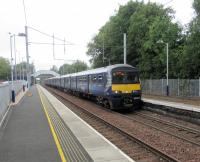Hamilton Branch (Caledonian Railway)
Introduction
This line is open to Passenger traffic and some goods traffic. The line is also known as the Hamilton Circle. The original line, promoted as part of the Clydesdale Junction Railway, ran from Newton to Hamilton. The line was later extended to Ferniegair and Motherwell, (Hamilton was renamed Hamilton West). The line is promoted and supported by the Rail 74 Community Rail Partnership .
Dates
Portions of line and locations
This line is divided into a number of portions.
Newton to Hamilton
The main part of the line, still open, runs from Newton station to Hamilton West.
This is a two platform station. The location was formerly a four platform station, the two northern tracks no longer have platforms and allow non-stop trains to bypass the station.
...
See also
Clydesdale Junction Railway
Glasgow Central Railway
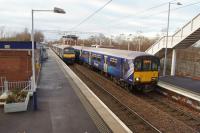
John McIntyre 10/01/2019
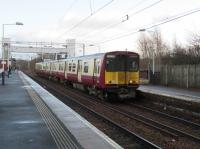
David Panton 11/12/2019

John McIntyre 10/01/2019
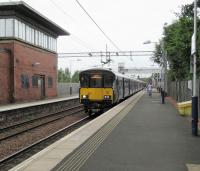
David Panton 08/09/2018
This junction is immediately east of Newton station. Here the Hamilton Branch (Caledonian Railway) separates from the Clydesdale Junction Railway and heads south east to Hamilton. Both lines opened in 1849.
...
See also
Clydesdale Junction Railway
This signal box was on the 1849 Hamilton Branch (Caledonian Railway) just south east of Hamilton Junction. Loops and sidings here served the eastern approach to the 1871 Hallside Steel Works and a mineral line ran south to Hallside Colliery.
...
This signal box was for the former mineral line south to Bardykes Colliery at Spittal Farm. The approach was from the north west, the line making a trailing connection opposite the box on the north side of the line.
...
This was the junction for the Bothwell Castle Colliery Pits Nos 3 and 4. The colliery was on the east side of the line.
...
This is a two platform station. It was opened on the Hamilton branch of the Caledonian Railway. There is a station building on the Glasgow bound platform and a car park.
...
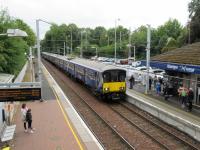
David Panton 08/09/2018

John Furnevel 18/08/2006
This junction was directly south of Blantyre station. It was between the 1849 Hamilton Branch (Caledonian Railway) and a curve opened in 1882 to allow coal trains from the 1860 Hamilton and Strathaven Railway direct access to Glasgow without reversal at Strathaven Junction. The far end of the curve was at Auchinraith Junction (also spelled Auchenraith).
...
See also
Hamilton and Strathaven Railway
This was not a junction in the strictest sense of two lines meeting, but the northern end of the large Strathaven Junction Yard.
...
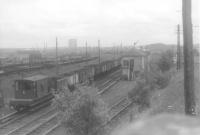
John Robin 02/07/1963
In 1860 the first part of the Hamilton and Strathaven Railway opened, climbing from the 1849 Hamilton Branch (Caledonian Railway) to the higher ground to the west at High Blantyre and then turn south, ultimately reaching Strathaven [Flemington]. In particular this line would, for its northern portion between Hamilton and Quarter, serve many collieries en route.
...
See also
Hamilton and Strathaven Railway
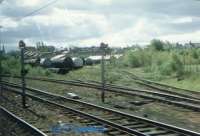
Ewan Crawford //
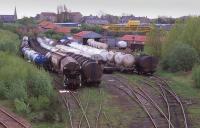
Bill Roberton /05/1993
This junction was north of Hamilton West station. A minimal version still exists today to give access to the Earnock Sidings of E.G. Steele, a wagon repair works. It formerly gave access to Hamilton Shed and mineral lines.
...
This single ended twelve road shed was located on the west side of the Hamilton Branch (Caledonian Railway) just north of Hamilton West.
...
This is a two platform station with a car park on its west side and entrance from Clydesdale Street, to the south.
...
See also
Hamilton to Ferniegair (Caledonian Railway)

Colin McDonald 27/01/2017

David Panton 22/06/2019

Colin McDonald 27/01/2017

John Furnevel 01/08/2006
Newton Goods Lines
South of Newton station was a goods loop, opened in 1871, serving Hallside Steel Works and several collieries. These lines are now lifted.
Newton West Junction is to the west of Newton station. It is where lines divide into the bypass lines, to the north, and platform lines, to the south. The platform lines are joined by the line from Kirkhill, to the south west, as they approach the station. This location is called Newton Kirkhill Junction although it used to come under Newton West Junction.
...
See also
Clydesdale Junction Railway
Lanarkshire and Ayrshire Railway
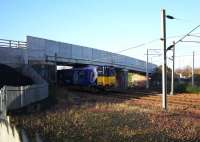
Colin McDonald 10/12/2015
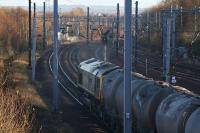
Colin McDonald 10/12/2015
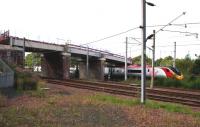
Colin McDonald 28/08/2015
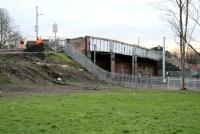
Colin McDonald 05/02/2015
To the immediate west of Newton the former Clydesdale Junction Railway and Lanarkshire and Ayrshire Railway part and run a short distance west before diverging.
...
See also
Lanarkshire and Ayrshire Railway
This steel works was to the south of Newton station. It was served by a goods loop which was added to the station's south, approach to the works being from the west. The works was opened by the Steel Company of Scotland, thus the original name of Newton West Junction: Steel Company of Scotland Works Junction.
...
This junction is immediately east of Newton station. Here the Hamilton Branch (Caledonian Railway) separates from the Clydesdale Junction Railway and heads south east to Hamilton. Both lines opened in 1849.
...
See also
Clydesdale Junction Railway
Earnock Colliery
A substantial branch ran from the Earnock Sidings to Earnock Colliery.

Ewan Crawford //

Bill Roberton /05/1993
Craighead and Strathaven Junction Yards
A series of large yards were located on the north side of the branch between Craighead Junction and Hamilton West. The yards were associated with the considerable coal industry in the area and flow of coal from the Coalburn Branch (Caledonian Railway).
This was not a junction in the strictest sense of two lines meeting, but the northern end of the large Strathaven Junction Yard.
...

John Robin 02/07/1963
This was a large marshalling yard to the north of Hamilton West. The yard was largely involved with the heavy coal traffic of Lanarkshire and developed alongside Strathaven Junction, expanding and reducing as demand required. Coal marshalled here was dispatched to Coatbridge, Motherwell and Glasgow. It is also known as Strathaven Junction North Yard and Hamilton Engine Sheds Yard.
...
This junction was north of Hamilton West station. A minimal version still exists today to give access to the Earnock Sidings of E.G. Steele, a wagon repair works. It formerly gave access to Hamilton Shed and mineral lines.
...
Bothwell Castle Colliery
A short branch served Bothwell Castle Colliery Pits Nos 3 and 4.
This was the junction for the Bothwell Castle Colliery Pits Nos 3 and 4. The colliery was on the east side of the line.
...
Also known as Priory Colliery. Opened by William Baird and Company. Reprieved 1951. ...
More details









